
Hungary
The city was for many centuries the Royal Seat, from the time of King Stephen. It celebrated its millenium in 972. Known alternatively as Alba Regia, thirty-eight kings were crowned here in the Royal Basilica, and eighteen of them were buried here. It was taken by the Turks in 1543 and when they left it in 1688 most of the former city was in ruins.
Today the old town is this city rebuilt, largely in Baroque forms, although some medieval fragments are preserved.The narrow streets open suddenly into open squares with fountains, and much is traffic-free. Around the old centre are today's modern roads, shopping centres and fast-food restaurants, with large blocks of appartments beyond these. About 120,000 people live here and the main sights can be seen comfortably in a few hours. We parked opposite the main bus terminals, close to the golden arches of an air-conditioned McDonalds (we know, we went in, it was so hot outside!). From here cross the main road and turn to the right (south), heading for a single baroque helm, my first church.
Carmelite Church
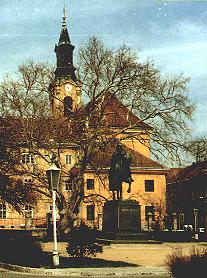
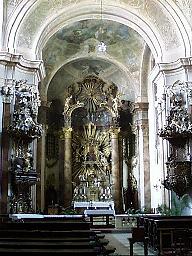
The church's main entrance is in Petöfi utca and was firmly locked. I am not sure why I did it, but imediately to the right of the church is another doorway to the former convent which I tried and found open. Here was a porter's lodge and an electronic door into the cloisters and a second supervised entrance into the church! The rest is now an old people's home for retired priests etc. The picture on the left is scanned from a postcard I bought here, the view from István tér to the east, for the church is near impossible to photograph well, due to either narrow streets or leafy trees! The interior is in stark contrast to the plain exterior, with wonderful frescoes by Franz Anton Maulbertsch from the Life of the Virgin, and two side altarpieces by the same artist depicting Joseph and St Anne. the church was built in 1730.
Cathedral Church of King Saint Stephen
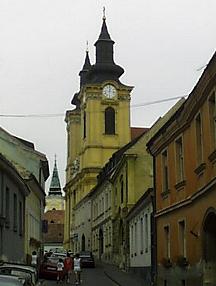
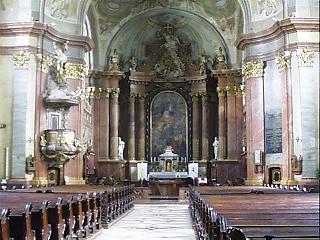
The present day cathedral (see founded in 1777) is built on a Romanesque site pre-1235, that of the Parish Church of the town, which was enlarged in the C15 and converted into a mosque in the Turkish occupation. The surviving building was altered again into the present Baroque appearance 1758-68. Twin west towers, and a sort of cruciform interior set around a large domed space. Unfortunately my visit was limited to the west end. Just to the north of the cathedral is
St Anne's Chapel
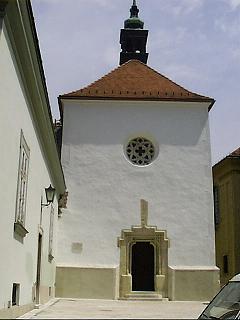
This small building is the only complete medieval building in today's Székesfehérvár. Built around 1470, the interior (not seen by me) preserves Turkish wall paintings. The doorway is original, the small rose window is C19 and the little turret is C18.
Franciscan Church (I think!)
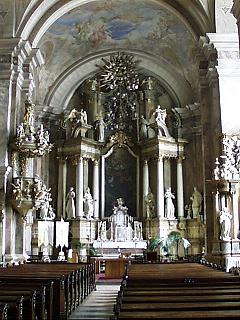
The road from the cathedral opens out into Városház tér, and on the northern side of the square is another beautiful baroque church, which I found that the guidebooks and town plan does not mention or identify. I did take a picture of the outside (which I shall add if it is OK) with the 35mm camera but these photos are being developed as I write. Like the others, this church is richly appointed and the walls and roof decorated in paintings.
To the far east of the square, behind the baroque bishop's palace is the Romkert, a garden with the excavated walls of the coronation basilica.
Cistercian Church
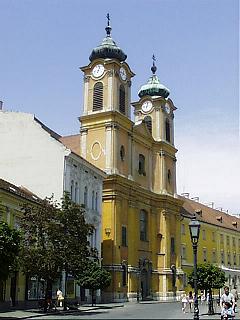 |
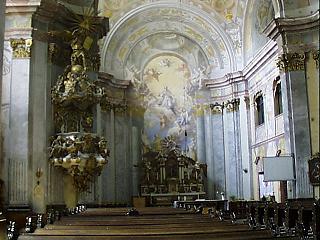 |
Either street from the northern end of the square will take you to what is considered the city's most beautiful church, that of the Cistercians. It is also the only one which has reversed orientation. The twin-towered façade dominated the wide Fö utca. It was built 1745-51 by the Jesuits but after a brief spell under the Paulite order the church became Cistercian in 1813. the church is large and has many frescoes and murals, including a trompe l'œil "apse" behind the main altar.
Back to the Hungary Pages Intro and Index